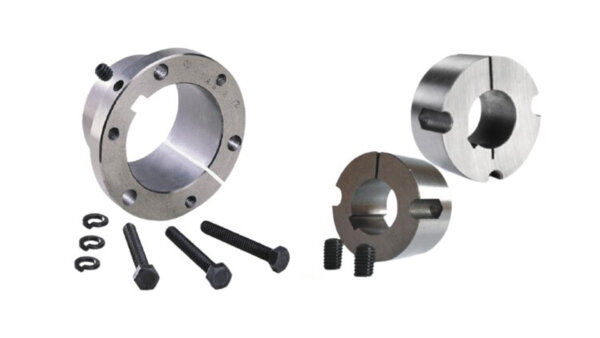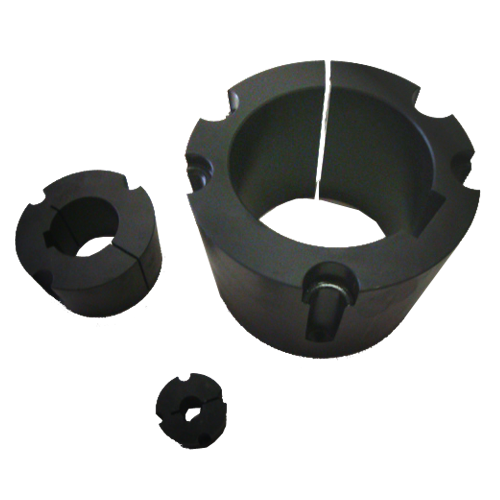Product Description
Product Description
| Taper Lock Bushing Cast Iron 3535 4545 |
Material: Cast Iron GG25, C45 Steel
Surface treatment: Black-phosphated or original color without finishing
Features of Taper Bushes:
*Easy on-easy off;
*Machined to high precise tolerance;
*A full range of both metric and inch sizes taper bushes are available;
*ISO9001:2008 certificated;
*Most of our Taper lock bushes are exported to Europe and North America.
Product Parameters
Packaging & Shipping
All the products can be packed in cartons,or,you can choose the pallet packing.
MADE IN CHINA can be pressed on wooden cases.Land,air,sea transportation are available.UPS,DHL,TNT,
FedEx and EMS are all supported.
Company Profile
FAQ
1. MOQ
A: Generally, 1 pc for standard parts; contact for nonstandard parts.
2. Delivery Time
A: In stock: within 5 working days. Out of stock: depends on your order quantity.
3. How To Select
A: part number or drawing, catalogue. If no, you can send us your sample, so we can make the drawing and sample accordingly.
4: What is the Warranty for your products?
A:Normally our warranty is 1 year.
| Standard or Nonstandard: | Standard |
|---|---|
| Feature: | Cold-Resistant, Corrosion-Resistant, Acid-Resistant |
| Application: | Conveyer Equipment |
| Surface Treatment: | Phosphating/Zinc Plating |
| Material: | Cast Iron |
| Product Name: | Taper Lock Bushing |
| Samples: |
US$ 2.52/Piece
1 Piece(Min.Order) | |
|---|
| Customization: |
Available
| Customized Request |
|---|

What are the temperature and environmental considerations when using taper bore bushings?
When using taper bore bushings, it is important to consider the temperature and environmental conditions in which they will be operating. These factors can significantly impact the performance, durability, and lifespan of the bushings. Here are some key considerations regarding temperature and environmental conditions:
Temperature:
Temperature plays a critical role in the functioning of taper bore bushings. Extreme temperatures can affect the material properties, lubrication, and dimensional stability of the bushings, leading to potential issues. Here are a few temperature-related considerations:
- Operating Temperature Range: Each taper bore bushing has a specified operating temperature range provided by the manufacturer. It is crucial to ensure that the temperature within the application falls within this range. Exceeding the upper or lower limits of the temperature range can result in premature wear, reduced load capacity, or even catastrophic failure of the bushings.
- Thermal Expansion: Taper bore bushings, like any other mechanical component, expand or contract with changes in temperature. It is important to account for the thermal expansion or contraction when selecting and installing the bushings. Failure to accommodate thermal effects can lead to misalignment, loss of interference fit, or excessive stress on the bushings.
- Heat Dissipation: In applications where the taper bore bushings are subjected to high temperatures, adequate heat dissipation measures should be implemented. This may include providing proper ventilation, using cooling systems, or selecting bushing materials with higher heat resistance. Effective heat dissipation helps to prevent overheating, which can degrade the performance and lifespan of the bushings.
- Temperature Cycling: If the application involves frequent temperature cycling, it is important to ensure that the taper bore bushings can withstand the thermal stress caused by repeated expansion and contraction. Bushings with good fatigue resistance and dimensional stability under cyclic temperature changes should be selected.
Environmental Conditions:
Environmental factors can also impact the performance and longevity of taper bore bushings. It is essential to consider the following environmental conditions:
- Corrosive or Chemically Aggressive Environments: If the application exposes the taper bore bushings to corrosive substances or chemically aggressive environments, it is crucial to select bushing materials that are resistant to corrosion or chemical attack. Stainless steel, certain alloys, or polymer-based bushings can be suitable choices in such environments.
- Dust, Dirt, and Contaminants: Dust, dirt, or other contaminants can accumulate on the surfaces of taper bore bushings, leading to increased friction, wear, or even binding. In dusty or dirty environments, regular cleaning and maintenance of the bushings are necessary to prevent performance degradation. Additionally, using protective covers or seals can help minimize the ingress of contaminants.
- Humidity and Moisture: High levels of humidity or exposure to moisture can promote corrosion and accelerate wear in taper bore bushings, especially those made from steel or other susceptible materials. In such environments, it is important to use corrosion-resistant bushings, apply proper lubrication, and ensure effective sealing to protect against moisture ingress.
- Shock and Vibration: Applications that involve significant levels of shock or vibration can affect the performance and longevity of taper bore bushings. Excessive vibrations can lead to loosening of the bushings or damage to the interference fit. Adequate measures such as proper mounting, use of vibration dampening materials, or employing vibration isolation techniques should be implemented to mitigate the impact of shock and vibration.
It is crucial to consult the manufacturer’s specifications, technical documents, or seek expert advice to ensure that the selected taper bore bushings are appropriate for the specific temperature and environmental conditions of your application. Proper consideration and implementation of temperature and environmental factors can help maximize the performance, reliability, and service life of the bushings.

What are the industry standards for taper bore bushings, and how do they impact their design and performance?
When it comes to taper bore bushings, several industry standards exist that define their design, dimensions, and performance characteristics. These standards play a crucial role in ensuring compatibility, interchangeability, and reliable performance across different manufacturers and applications. Here are some of the key industry standards for taper bore bushings and their impact on design and performance:
- ISO 9001: ISO 9001 is a widely recognized international standard for quality management systems. While it does not specifically focus on taper bore bushings, it sets general guidelines for quality control and assurance in manufacturing processes. Adherence to ISO 9001 ensures that manufacturers follow consistent procedures, maintain quality control measures, and meet customer expectations in terms of product performance and reliability.
- ANSI B17.1: ANSI B17.1, also known as the American National Standard for Keys and Keyseats, provides guidelines for the design and dimensions of taper bore bushings in the United States. It specifies keyway dimensions, tolerances, and other critical parameters to ensure compatibility between taper bore bushings and corresponding shafts or hubs.
- DIN 6885: DIN 6885 is a German standard that defines parallel keys and keyways. It includes specifications for taper bore bushings used in European markets. DIN 6885 provides guidance on keyway dimensions, tolerances, and key material selection, ensuring proper fit and alignment between bushings and shafts.
- AGMA 9002: AGMA 9002, published by the American Gear Manufacturers Association, offers guidelines for the design, selection, and application of taper bore bushings in power transmission systems. It covers factors such as load capacity, torque transmission, and alignment considerations. AGMA 9002 helps ensure that taper bore bushing designs meet industry requirements and provide reliable performance in demanding applications.
- ASTM Standards: The American Society for Testing and Materials (ASTM) has several standards that apply to taper bore bushings, particularly those made from specific materials. ASTM standards define material specifications, mechanical properties, and testing methods, ensuring consistent quality and performance of bushings made from materials such as steel, bronze, or polymers.
Industry standards have a significant impact on the design and performance of taper bore bushings. They ensure dimensional compatibility between bushings and associated components, such as shafts or hubs, allowing for easy installation and interchangeability. Standards also establish tolerances, load capacities, and other performance requirements, ensuring that bushings can handle the intended loads and operating conditions.
By adhering to industry standards, manufacturers can provide reliable and consistent taper bore bushings that meet customer expectations in terms of performance, quality, and safety. Standardized dimensions and specifications also facilitate the integration of bushings into larger systems and enable easy replacement or retrofitting when needed.
When selecting taper bore bushings, it’s important to consider the relevant industry standards and ensure that the chosen bushings comply with the applicable requirements. Manufacturers often provide information on their product packaging, datasheets, or websites regarding the standards their bushings adhere to.
By following industry standards and selecting bushings that meet these specifications, you can have confidence in the design, compatibility, and performance of taper bore bushings in your applications.

What is a taper bore bushing, and how does it enhance the performance of machinery?
A taper bore bushing is a type of bushing that features a tapered inner bore. It is designed to be mounted on a shaft with a corresponding tapered outer surface, creating a tight and secure fit. Taper bore bushings are commonly used in various machinery and power transmission applications to enhance performance and reliability. Here’s an overview of how taper bore bushings work and their benefits:
Taper bore bushings are typically made of high-quality materials such as steel or cast iron. They consist of an outer flange, a tapered inner bore, and mounting holes for securing the bushing onto a shaft. The tapered inner bore allows the bushing to be easily mounted and removed from the shaft by tightening or loosening the mounting screws.
When a taper bore bushing is installed on a shaft, it provides several performance-enhancing benefits:
- Improved Shaft Grip: The taper bore design creates a strong and secure grip between the bushing and the shaft. As the mounting screws are tightened, the bushing expands radially, exerting pressure against the tapered shaft surface. This frictional force enhances the mechanical connection, preventing slippage or movement between the bushing and the shaft. The improved grip ensures efficient power transmission and minimizes shaft misalignment.
- Easy Installation and Removal: Taper bore bushings offer convenient installation and removal processes. To install the bushing, it is slid onto the tapered shaft and positioned at the desired location. As the mounting screws are tightened, the bushing securely grips the shaft. When removal is required, loosening the mounting screws releases the grip, allowing easy disassembly. This ease of installation and removal saves time and effort during maintenance or component replacement.
- Versatility and Adaptability: Taper bore bushings are available in a range of sizes and taper angles, allowing for versatility and adaptability in various applications. They can accommodate different shaft sizes and configurations, making them suitable for a wide range of machinery and power transmission systems. This flexibility simplifies inventory management and enables the use of standard taper bore bushings across multiple equipment types.
- Reduced Vibrations and Noise: The tight fit between the taper bore bushing and the shaft minimizes vibrations and noise. The secure connection helps dampen vibrations that may occur during operation, reducing the overall noise level and enhancing the smoothness of the machinery. This can contribute to improved operator comfort, reduced wear on other components, and increased overall system efficiency.
- Enhanced Reliability and Durability: Taper bore bushings provide a robust and reliable connection between the shaft and other components. The secure grip minimizes the risk of shaft movement or disengagement, reducing the likelihood of component damage, system failures, or unplanned downtime. Additionally, the use of high-quality materials in the construction of taper bore bushings ensures durability and long service life, even in demanding operating conditions.
Overall, taper bore bushings play a crucial role in enhancing the performance of machinery by providing a secure, reliable, and efficient connection between rotating shafts and other components. Their ability to grip the shaft tightly, ease of installation and removal, versatility, vibration damping, and durability make them valuable components in power transmission systems.


editor by CX 2023-10-27
